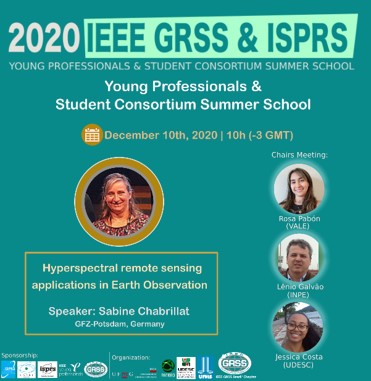Special Lecture: Hyperspectral remote sensing applications in Earth Observation
Summary.
Advanced optical remote sensing with >100 narrow contiguous spectral bands covering the visible-near infrared and short wave infrared (400-2500 nm), also called hyperspectral imagery or imaging spectroscopy enables us direct identification and quantification of constituents at the Earth surface since it can provide laboratory-like reflectance spectroscopy at the remote sensing scale. Nowadays continuous developments of proximal, airborne, and spaceborne sensors demonstrated the successful application of imaging spectroscopy for bare Earth surface characterization, and intense preparations for upcoming hyperspectral missions are ongoing.
The objective of this presentation is to introduce basic concepts related to reflectance and imaging spectroscopy applied to the characterization of Earth surface composition with a focus on drylands, soil, and mineralogical surfaces, and to show current and upcoming sensor developments towards quantitative Earth surface mapping from space. First, a review of the physical background for the identification of surface constituents from spectral reflectance and basics of imaging spectroscopy will be presented, followed by state-of-the-art science case studies of applications in imaging spectroscopy from laboratory, field, air-, and spaceborne platforms with highlights from the EnMAP mission science preparation program. Finally, perspectives from forthcoming hyperspectral missions and synergies with other missions will be discussed along with an update on the space missions available and planned in imaging spectroscopy.
About the Speaker
Dr. Sabine Chabrillat is Senior Research Scientist at the GFZ German Research Center for Geoscience in Potsdam, Germany, head of the research group on ‘Hyperspectral remote sensing applications’ and head of the GFZ spectroscopy laboratory. She leads a number of projects on the retrieval of Earth surface composition from hyperspectral imagery based on laboratory, field, air-, and spaceborne platforms. Her research focuses on drylands and topsoil essential variables (organic carbon, texture, soil moisture, vegetation cover).
Dr. Sabine Chabrillat is lead Science Principal Investigator of the upcoming german EnMAP hyperspectral satellite, chair of the EnMAP Science Advisory group, and chair of the IEEE-Standard Association Working Group on standards and protocols for soil spectroscopy. She is a member of the ESA Mission Advisory group for the hyperspectral Copernicus High Priority Candidate Mission CHIME.
Holder of a scientific record of >220 publications and communications in the field of hyperspectral imagery and Earth sciences, she is a regular conference chair in scientific meetings, lecturer in remote sensing, and reviewer in university committees. Dr. Sabine Chabrillat did her post-doctorate at the Center for the Study of Earth from Space (CSES/CIRES) at the University of Colorado, Boulder, USA, and holds a Ph.D. from the University of Toulouse, France, on hyperspectral imagery analyses.


